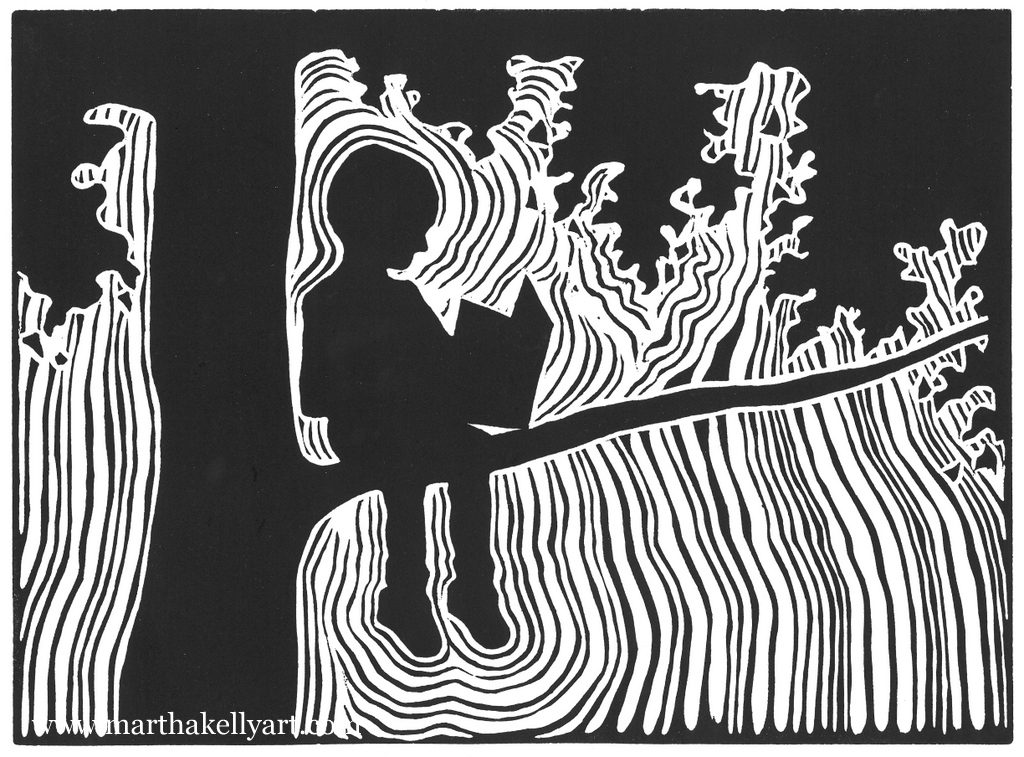Carol Levine
New York, New York, United States
 |
| Linoleum block print “Good Book” by Martha Kelly |
Mental illness casts a wide net, enmeshing patient, family, and doctors. When the patient is young, the main characters are usually parents, who struggle with love, guilt, fear, and despair. Yet families are often secondary, sometimes shadowy, characters in clinical accounts. Fiction allows parents to be the primary actors, even as their own stories revolve around their ill children.
Cases in point: two remarkable short stories published 64 years apart–“Signs and Symbols” by Vladimir Nabokov in 1948 and “Referential” by Lorrie Moore in 2012. They demonstrate that, contrary to Shakespeare’s reflection in King John, life is not “as tedious as a twice-told tale.” In a recent 400-page essay collection, literary, medical, and linguistic experts analyze every aspect of Nabokov’s 2,160 words. Moore’s rereading of Nabokov’s story led her, she says, to try to “write something that tracked the Nabokov closely but also did its own thing….”
Although set in different eras, both stories tell essentially the same sad tale of parents’ visits to a psychiatric hospital to see a son, a boy really, who has attempted suicide. In Nabokov, the boy’s most recent attempt had been, a doctor said, “a masterpiece of inventiveness; he would have succeeded, had not an envious patient thought he was learning to fly—and stopped him.” Moore’s boy cuts himself to achieve the same end.
The parents (in “Referential,” the single mother is accompanied by Pete, her on-again, off-again boyfriend) visit the boy bearing a birthday gift (jars of jellies, a book) carefully chosen to conform to the facility’s rules. The visits do not go well, and the parents consider bringing him home where they can take turns watching him. At home at night, the telephone rings three times. Who is calling? What is the message?
In both stories readers are left to decide. Having traveled to the psychiatric hospital and back again with the parents, we have entered their lives, shared their uncertainty and worry. Like them, we look back to see what clues we might have missed, not just in the story but in their history.
In Nabokov, the son was ten years old when the family left Europe to escape Nazi persecution. In America, the mother felt “the shame, the pity, the humiliating difficulties, the ugly, vicious, backward children he was with in that special school.” Even earlier he had been “afraid of the wallpaper in the passage, afraid of certain picture in a book which merely showed an idyllic landscape….” Was his fear of objects and natural phenomena a byproduct of the persecution his family experienced in Europe and the bullying he encountered in America or something totally unrelated? In Moore, the mother is a widow; there is no other family background.
What is the meaning of the mysterious telephone calls? In Nabokov, the first two calls are wrong numbers. A “dull-voiced girl” asks for “Charlie,” and on the second such call the mother helpfully explains, “I will tell you what you are doing; you are turning the letter O instead of the zero.” Surely these symbols – a circle and nothingness—mean something. But what? Then the father begins to drink his tea and re-examines the labels on the glass jars of fruit jellies they had brought to their boy. “He had got to crab apple, when the telephone rang again.” End of story.
In “Referential,” there is no one on the phone in the first call. The mother lies about the second telephone call, telling Pete it was coming from his apartment. Pete’s rather hurried departure tells her that the “romantic overlaps” he had when they first met are happening again. Then the phone rings a third time. “What would burst forth? A monkey’s paw. A lady. A tiger. But there was nothing at all.” End of story.
In King John, King Philip criticizes a grieving mother for her expressions of sorrow. She replies, “He talks to me that never had a son.” Nabokov and Moore let us share the suffering of fictional parents with sons and by extension, all parents of ill children.
Notes
- Vladimir Nabokov, “Signs and Symbols,” in The Stories of Vladimir
- Nabokov (New York: Vintage International, 1995), pp. 598-603. Originally published in The New Yorker in slightly different form May 15, 1948, with the title “Symbols and Signs.”
- Lorrie Moore, “Referential,” in Bark: Stories (New York: Knopf, 2014), pp. 149-157.Originally published in The New Yorker in slightly different form May 28, 2012.
- William Shakespeare, King John: Act 3, Scene 4. http://www.william-shakespeare.info/shakespeare-play-king-john.htm. Accessed April 20, 2015.
- Yuri Leving, ed., Anatomy of a Short Story: Nabokov’s Puzzles, Codes, ‘Signs and Symbols.’” (New York: Continuum International Publishing Group, 2012).
- Gaby Wood, Gaby. Interview with Lorrie Moore, The Telegraph, March 2, 2014. http://www.telegraph.co.uk/culture/books/authorinterviews/6256085/Lorrie-Moore-interview.html. Accessed April 19, 2015.
- Shakespeare, King John, ibid.
CAROL LEVINE directs the Families and Health Care Project at the United Hospital Fund in New York City. She received a MacArthur Fellowship for her work in medical ethics and HIV/AIDS. She is the editor of Living in the Land of Limbo: Fiction and Poetry about Family Caregiving (Nashville: Vanderbilt University Press, 2014).
Highlighted in Frontispiece Winter 2016 – Volume 8, Issue 1
Winter 2016 | Sections | Psychiatry & Psychology

Leave a Reply